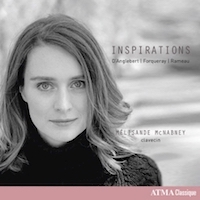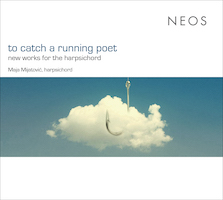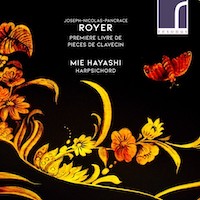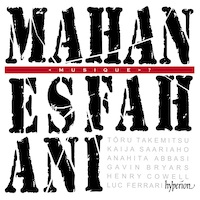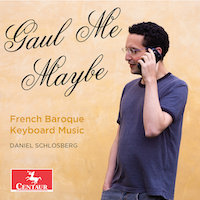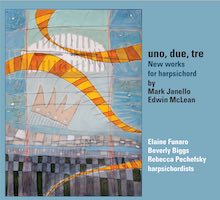Pièces de Clavecin 12: Old and New
|
Grant Chu Covell [February 2021.]
“Inspirations.” Jean Henry D’ANGLEBERT: Suite in C (1675); Prélude (1689); Tombeau de Mr de Chambonnières (1689); Passacaille d’Armide (1689). Antoine FORQUERAY and Jean-Baptiste-Antoine FORQUERAY: Excerpts from Suite No. 5 (1747). Jean-Philippe RAMEAU: Tendre amour from Les Indes Galantes (1735; arr. M. McNABNEY); Air de la Folie from Platée (1745; arr. M. McNABNEY); Sarabande from Suites de pièces de clavecin (1729). Mélisande McNabney (hpsi). Atma ACD2 2780 (1 CD) (www.atmaclassique.com). McNabney reminds that much French Baroque music we associate with harpsichord may have originally been intended for other forces. Except for the unmeasured prelude, the D’Anglebert Suite arranges lute pieces by Ennemond Gautier and René Mesangeau. The Passacaille d’Armide is by Lully. The Forqueray Suite exists in both solo harpsichord and viola da gamba versions. Rameau often recycled keyboard pièces in his operas (the Sarabande found its way into Zoroastre), and here McNabney reverses the process with extracts from Les Indes Galantes and Platée. McNabney is a musician to watch: Right from the start we are drawn into the lyricism of the D’Anglebert Suite. The distance between D’Anglebert and Forqueray is several generations, intimate to orchestral, linear to chromatic. McNabney is a conversational player with fluid but not hurried tempos. Forqueray’s dissonances are not exaggerated, Jupiter is gallant rather than impetuous. Effortless and uplifting, Rameau’s Sarabande may be my favorite of all 18 tracks. McNabney employs three easily discernable tuning systems: the resonant Chaumont (1695) for D’Anglebert, essentially quarter-comma meantone, Rameau (1726) for Rameau which offers colorful thirds as the harmonies drift, and D’Alembert/Rousseau (1752/1767) for Forqueray which rings closest to our times. McNabney plays a 1981 Keith Hill after Blanchet.
“To Catch a Running Poet: New Works for the Harpsichord.” Margareta FEREK-PETRIĆ: Ištaratu (2016). Rafael NASSIF: empty-forms (2017). Christian DIENDORFER: PSI (2005); PSI Song (2010). Sylvie LACROIX: “courante” (2013). Peter JAKOBER: dringen (2017). Tamara FRIEBEL: Dance me to my Rebirth (2017). Manuela KERER: Granat (2017). Hannes DUFEK: arresting images (2014/2017). Maja Mijatović (hpsi). Neos 11906 (1 CD) (www.neos-music.com). Mijatović powers through a fresh slate of dynamic harpsichord works. Eight composers are represented by nine extroverted pieces. All the works are on the short side (nothing longer than 12 minutes), and all are non-tonal, frequently dissonant, and tend towards complexity. Fast fingers are the norm; each piece has something to prove. The works that stand out are those that momentarily dabble in quiet (“courante”, Dance Me To My Rebirth) or contain violent flashes (dringen, arresting images). (By the way, can someone tell me what is with all these lower-case titles?) Concluding with a simulated shriek (a scraped string), Ištaratu, based on the Babylonian goddess Ištar who embodies both love and war, animatedly explores male, female and non-binary entities. empty-forms leverages non-keyboard sounds: activating the damper, shifting the manuals, directly plucking the strings, etc. Diendorfer’s PSI pair employ classical harpsichord gestures (rolled chords, Alberti bass) with modern pitches and popular riffs. Lacroix’ “courante” includes prepared sounds (e.g., a piece of paper) and strumming the strings directly. In three movements, Friebel’s Dance me to my Rebirth envisions “the course of a pregnancy from the inside.” The score includes ping pong balls and live electronics. Kerer’s Granat is inspired by the pomegranate and the numbers 16 and 18 (the number of chromosomes in the fruit’s DNA). After a point, these lively compositions fuse together. The works with tape and electronics tend to duplicate the harpsichord: Jakober’s dringen sustains a continual throbbing between instrument and gradually detuning doubles, Dufek’s arresting images offers echoes and explosions.
Joseph-Nicolas-Pancrace ROYER: Premiere Livre de Clavecin (1746). Mie Hayashi (hpsi). Resonance RES10236 (1 CD) (www.resonusclassics.com). As they are so rare, I want to like all Royer recordings. (Excepting an oddity on Spotify where the “pianist” ignores the French instructions for shorthand chords and second endings which ludicrously disfigures the rondeau form in La Marche des Scythes.) Hayashi navigates Royer with modest gravity, maintaining even tempos. But I wanted Le Vertigo to be dizzier, more swagger in the Allemande, and perhaps predictably, more recklessness in La Marche des Scythes. Quite likely Hayashi is not well served by the instrument or the recording itself. Hayashi plays an instrument by Andrew Garlick, 2010, after an original by Jean-Claude Goujon (Paris, 1749), possibly tuned in modern temperament. Perhaps recorded at a distance, we hear little of the instrument’s mechanics, such as the gasp of silence before a big attack or the clatter of descending jacks. This recording lacks that requisite harpsichord crunch. Oddly, the instrument does not decay quickly, but this does not increase warmth. (La Chasse de Zaïde is not included. Strictly speaking, it’s not in Royer’s Premiere Livre, but many performers include it for completeness.)
“«Musique»?” Tōru TAKEMITSU: Rain Dreaming (1986). Henry COWELL: Set of four (1960). Kaija SAARIAHO: Jardin secret II (1986). Gavin BRYARS: After Handel’s ‘Vesper’ (1995). Anahita ABBASI: Intertwined distances (2018). Luc FERRARI: Programme commun « Musique socialiste ? » (1972). Mahan Esfahani (hpsi). Hyperion CDA68287 (1 CD) (www.harmoniamundi.fr). Not for the faint of heart, Esfahani’s recital of contemporary works asserts bold challenges. Three pieces require interaction with tape or electronics (Jardin secret II, Intertwined distances and Programme commun). From the harpsichordist’s preface: “One perhaps unlikely source of inspiration has been the people who, over the years, booed, cat-called, and/or walked out of halls worldwide in anger and confusion (in other words, fear) during the live performances of these and many other modern and contemporary works.” Takemitsu’s Rain Dreaming leverages a repeating cell. Are we dreaming of rain? Is the rain dreaming? A gentle motive suggesting light rain is buffeted with turbulent phases. Cowell’s grouping recalls the days when the harpsichord was antique, and no one yet knew how to use it in contemporary music. The four pieces include a big-boned Rondo, a jazzy Ostinato, a Chorale with rolled clusters, and a reprising Fugue – Résumé. Esfahani summons Landowska’s gigantic instrumental sound. (Esfahani plays an instrument by Jukka Ollikka, Prague, 2018, modelled after Michael Mietke.) In Saariaho’s Jardin secret II, the harpsichord survives an aggressive interaction with tape including volleys of creepy sounds (breathing, transformed vocalizations, etc.). After Handel’s ‘Vesper’ is an ordinary rumination fueled by Bryars’ experience working with Cage on HPSCHD, the music of Frescobaldi, and Raymond Roussel’s fictional account of Handel creating an oratorio. The player is requested to add ornamentation to Bryars’ improvisational long-winded sauntering. Abbasi’s Intertwined distances derives its electronic component exclusively from harpsichord sounds. The most recent work here, the piece appears to be less ambivalent than either Jardin secret II or Ferrari’s Programme commun, in that the harpsichord plus electronics blend to create a consistent universe. Biased because it is the piece I know best, and not just because it is the final and longest entry (19:37), I greet Ferrari’s Programme commun as the program’s culmination. Chojnacka’s 1990 recording (Adda 581224) is the benchmark. Esfahani’s realization is more violent than Chojnacka’s, but offers a more mysterious ending when the crickets overwhelm the sparse high pitches. The booklet offers: “No harpsichords were harmed in the making of this recording[.]”
“Gaul Me Maybe: French Baroque Keyboard Music.” Jean Henri D’ANGLEBERT: Prélude from Suite No. 3 in D minor (1689); Tombeau de Monsieur de Chambonnières (1689). Joseph-Nicolas-Pancrace ROYER: La Majestueuse from Premiere Livre de Clavecin (1746). Jean-Phillipe RAMEAU: Musette en rondeau and Tambourin from Suite in E minor (1724). Marin MARAIS: Le Badinage from Pièces de viole, Livre IV (1717). J.S. BACH: Overture in the French Style, BWV 831 (1735). Daniel Schlosberg (pno). Centaur CRC 3477 (1 CD) (www.centaurrecords.com). Pianist Schlosberg offers a personal glance at the French Baroque with Bach’s French Overture as a centerpiece. The notes touch on how the pianist came to some of these works via Scott Ross and Jordi Savall. Schlosberg’s articulation is mighty fine: He deftly conveys the melancholy of d’Anglebert’s Prélude and crafts a pensive left-hand etude from Marais’ Le Badinage (originally for viol, here offered on a dampened piano). The two Rameau pieces, themselves opera transcriptions, convey the continent’s stately dances. For Tambourin Schlosberg prepares the piano with a chain so that it rattles something like a harpsichord. Royer’s La Majestueuse is the most modern item in the collection, but as the first pièce among its published collection, it looked backwards to the courante (subsequent pièces are no longer danceable). Contrasting with Bach’s Courante in BWV 831, one notices a consistency in volume, whereas Royer implies an orchestra, if not continuo support. The booklet and track list incorrectly attribute the Rameau excerpts to Couperin.
“Uno, Due, Tre.” Edwin McLEAN: Sonata No. 3 for harpsichord (2015)1; Sonata No. 1 for two harpsichords (1992)2; Sonata No. 2 for two harpsichords (2014)3; Sonata for Three Harpsichords (1998)4. Mark JANELLO: Concerto for Two (2015)5; Toccata-Rondo for harpsichord (2012)6. Elaine Funaro1,2,3,4,5,6, Rebecca Pechefsky2,4,5, Beverly Biggs3,4 (hpsi). Aliénor Records ARCD-1210 (1 CD) (www.elainefunaromusic.com). An album of relatively recent items for one, two or three harpsichords. McLean’s multi-movement sonatas are consistent across the years, lovingly incorporating jazzy syncopation and popular chord progressions from recent decades. Janello’s two-harpsichord concerto is astutely ironic, taking modern swipes at Italian Baroque forms and gestures in irregular meters. Unlike the disarmingly concise McLean, Janello’s motives become recognizable as they develop. Brightly recorded so that each harpsichord’s personality emerges distinctly.
Abbasi, Bach, Bryars, Cowell, D'Anglebert, Diendorfer, Dufek, E McLean, Ferek-Petrić, Ferrari, Forqueray, Friebel, Jakober, Janello, Kerer, Lacroix, Marais, McNabney, Nassif, Rameau, Royer, Saariaho, Takemitsu
[More Grant Chu Covell, Pieces de Clavecin]
[More
Abbasi, Bach, Bryars, Cowell, D'Anglebert, Diendorfer, Dufek, E McLean, Ferek-Petrić, Ferrari, Forqueray, Friebel, Jakober, Janello, Kerer, Lacroix, Marais, McNabney, Nassif, Rameau, Royer, Saariaho, Takemitsu]
[Previous Article:
Used Bin Troll Tweets VV.]
[Next Article:
Piano Factory 28.]
|
